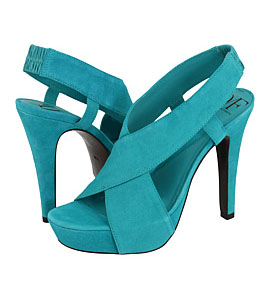How Many Pairs of Shoes Do You Own? Shoe Buying Tips and More
What: The average woman has 19 pairs of shoes, but only wears three pairs on a regular basis, according to a national poll of over 1,000 women conducted by Consumer […]

What: The average woman has 19 pairs of shoes, but only wears three pairs on a regular basis, according to a national poll of over 1,000 women conducted by Consumer Report’s ShopSmart Magazine. The magazine also offers tips on buying shoes (after the jump).
From ShopSmart:
Over half of women (51%) own more than 10 pairs and 13 percent have over 30 pairs (not including athletic shoes). The poll also found that women typically purchase three pairs a year and, on average, spend $49 on a pair of shoes, while nearly one-third (31%) have ever spent over $100 on a single pair.
Kathryn Says: Shoes and accessories like earrings and necklaces are the great democratizers of fashion. These are accessible accessories that you can wear regardless of your physical size and easy to find at all price points. Rarely do you have a “I-shouldn’t-have-eaten-that-Godiva-Chocolate-Cheesecake-at-Cheesecake-Factory” moment while shopping for shoes (jeans, on the other hand, are a whole different, sad, story). Also shoes are a relatively inexpensive (according to the poll the average woman spends about $49 on a pair of shoes) and easy (you don’t have to go into a fitting room to try on a pair of shoes) purchase, van hire west london. What I found interesting was that almost 50% of the women surveyed have a had a shoe-related injury, and anecdotal, this is an issue that touches me directly, as I broken my ankle due to poor footwear.
Check Out ShopSmart’s Shoe Buying Tips After the Jump
1. HEEL CUP This is the curved back of the shoe that contains and supports your heel. It should fit snugly enough to provide support and prevent slipping while walking, yet not be so tight or stiff that it causes discomfort, which can lead to blisters.
2. STRAPS A strappy sandal or pump provides extra breathability. Straps and laces also let you adjust shoes to fit your foot. Just make sure they don’t rub. Elastic is better than rigid straps, as long as it doesn’t cut into your foot. T-straps support the front of the foot.
3. PADDING AND ARCH SUPPORT Press down with your fingers inside the shoe: The more springiness, the better they’ll feel. Some brands incorporate extra cushioning at key pressure points (Cole Haan with Nike Air technology, Hush Puppies, Kenneth Cole’s Gentle Souls line). A shoe’s arch should match the location of your own.
4. THE HEEL If you like a heel, aim for one that’s between a half-inch and 2½ or 3 inches max. Anything higher can cause foot and back pain. The wider the heel, the more stable the shoe: A platform or stacked heel trumps a stiletto. The heel should be positioned under the center of your own heel, not set too far back. And of course, a closed heel adds stability to a shoe or sandal.
5. DEGREE OF INCLINE A gradual ascent puts less pressure on the ball of the foot.
6. THE SOLE You want some firmness and note that a softsoled ballet flat is no better than a slipper. Rubber or leather beats flimsy plastic.
7. ORNAMENTATION If the shoe has buckles or other decorative trimmings, make sure they’re not attached where your foot bends, like across your toes, or they might be killers.
8. TOP STITCHING Shoes with tiny chain stitches around the top can’t be stretched, and the leather is less pliable. Exposed stitches inside shoes can rub and irritate toes. So can linings that peel back, so look for a full lining, top and bottom, heel to toe. Calfskin is more breathable than cheaper pigskin (which can be identified by small, visible pores).
9. THE UPPER Go natural. Suede is the softest, foot-friendliest material, followed by breathable leather. Fabrics are fine if they’re not stiff. Patent and mirrored leathers have coatings that make them less pliable, and synthetics are the least forgiving.
10. THE TOE BOX Round or almond shape toe boxes mirror the foot’s shape and have room for toes to spread out. There should be enough room for your toes to move as you walk, yet not so much that your foot slides around in the toe box. Pointy shoes aren’t necessarily bad; make sure the exaggerated tip starts half an inch after the base of your toes.
You can leave a response, or trackback from your own site.
Leave a Reply
You must be logged in to post a comment.

No Responses to this article